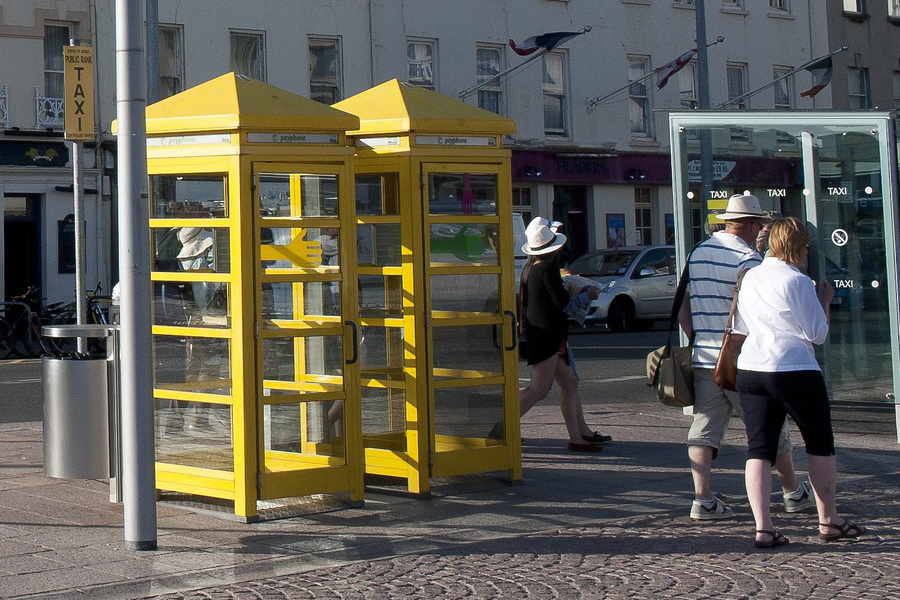- The Island’s 104 public telephone boxes will now be free to use.
- Jersey Telecom have launched the initiative to provide help in emergency situations.
- With most Islanders now owning mobile phones, the use of telephone boxes has declined hugely.
- Find out about the history of telephone boxes in Jersey below.
ISLANDERS are now able to make free local calls from Jersey’s telephone boxes under a new initiative announced by Jersey Telecom.
It is hoped that the service may provide help in emergency situations in the absence of mobile phones.
Of the 104 public phone boxes in Jersey 60 are in St Helier, including at the Harbour and at the Hospital.
Owing to the rise in mobile phone ownership, phone boxes have experienced a huge decline in use.
In some parts of the UK disused boxes have been turned into Wi-Fi hotspots or community defibrillator stations in remote rural areas.
Tim Ringsdore, chief relationship officer at JT, said that while Jersey had seen a similar decline in the use of phone boxes, the company felt that there was still a need to provide payphones in the Island.
He said: ‘From our research and listening to customers throughout the community, we recognise phone boxes are still used and we hope, by offering local calls for free, we are helping people who rely upon them for day-to-day communication and to the wider community.
‘Phone boxes can still play a very important role in an emergency or, for example, when someone loses their mobile phone, or when they are without credit or battery life on their mobile.
‘By providing these free calls we can help ensure that for those people, particularly the young, or those without a mobile phone, that phone boxes are there to be used and we hope that, by offering free local calls, people will once again recognise the important role they play in our community.’
- Before the Great War there were few public call offices. Under the National Telephone Company up to 1912 and thereafter under General Post Office (GPO) control, there were public phones provided at many locations including the railway company stations, post offices and telephone exchanges but no kiosks.
- There is only one record of a kiosk before 1923, which was erected at the Weighbridge in 1902, but survived for just a few months from May to December.
- It was not until after the States took over the telephone system in 1923 that public street kiosks began to appear. These were of individual design and were constructed from wood and glass. Local building firms were commissioned to construct them on an ad hoc basis.
- Following the acquisition of the entire local telephone system from the GPO, the newly formed States Telephone Department set about a comprehensive programme of installing public telephone kiosks in convenient locations around the island.
- No less than 28 kiosks were installed between 1923 and 1926 all around the Island.
- The Jersey Evening Post reported in January 1938 that new kiosks of a local design were being installed instead of the heavy concrete types.
- In the late 1950s the Telephone Department experimented with kiosks made from fibreglass by the local company Precision Plastics Limited.
- In 1980 the States of Jersey Telephone Department ordered 12 GPO Kiosks K8 from the GPO supplies department. This was the only large purchase of GPO standard kiosks ever made by the States of Jersey and these were installed mainly around St Helier. All were the first boxes to be finished in the new standard yellow livery.
- A brief experiment was initiated in December 1979 with some open type aluminium kiosk phones imported from the US. These proved unsuccessful due to the Islands weather conditions.
- In 1988 Jersey Telecoms introduced card operated call boxes and operated almost all its public kiosks as card only from 1994 up until 2004.
- In 1997 a new style kiosk largely designed by Jersey Telecoms was introduced and a trial was begun to test its suitability and popularity with the public. Jersey Telecoms began a comprehensive upgrade of all its telephone kiosks in the year 2000 with the initial replacement of 40 existing kiosks with this new design.
*Source: A History of the Telephone Kiosk in Jersey, by Graeme Marett

- In June 1896 a tender was invited for the provision of police telephone boxes to be installed around the town of St Helier.
- This was to enable the police to report back to the police station, then located at St Helier Town Hall, during their patrols or if specific help was needed.
- It is not known whether these boxes were connected to the police switchboard by private circuits erected by the electrician or via the National Telephone Company facilities.
- The first of eight cast-iron wall boxes enclosing the telephone was installed at the Harbour Masters office, Albert Pier on 1 October that year.
- Each box contained a magneto telephone with detachable earpiece and a small writing shelf.
- The remaining boxes were installed around the town, including one at the corner of Val Plaisant and David Place.
- These boxes were also accessible by the public as the keys needed to access them were often available from nearby shops.
- This system of communication was abandoned in 1923 following the takeover of the telephone system by the States of Jersey.
*Source: A History of the Telephone Kiosk in Jersey, by Graeme Marett






